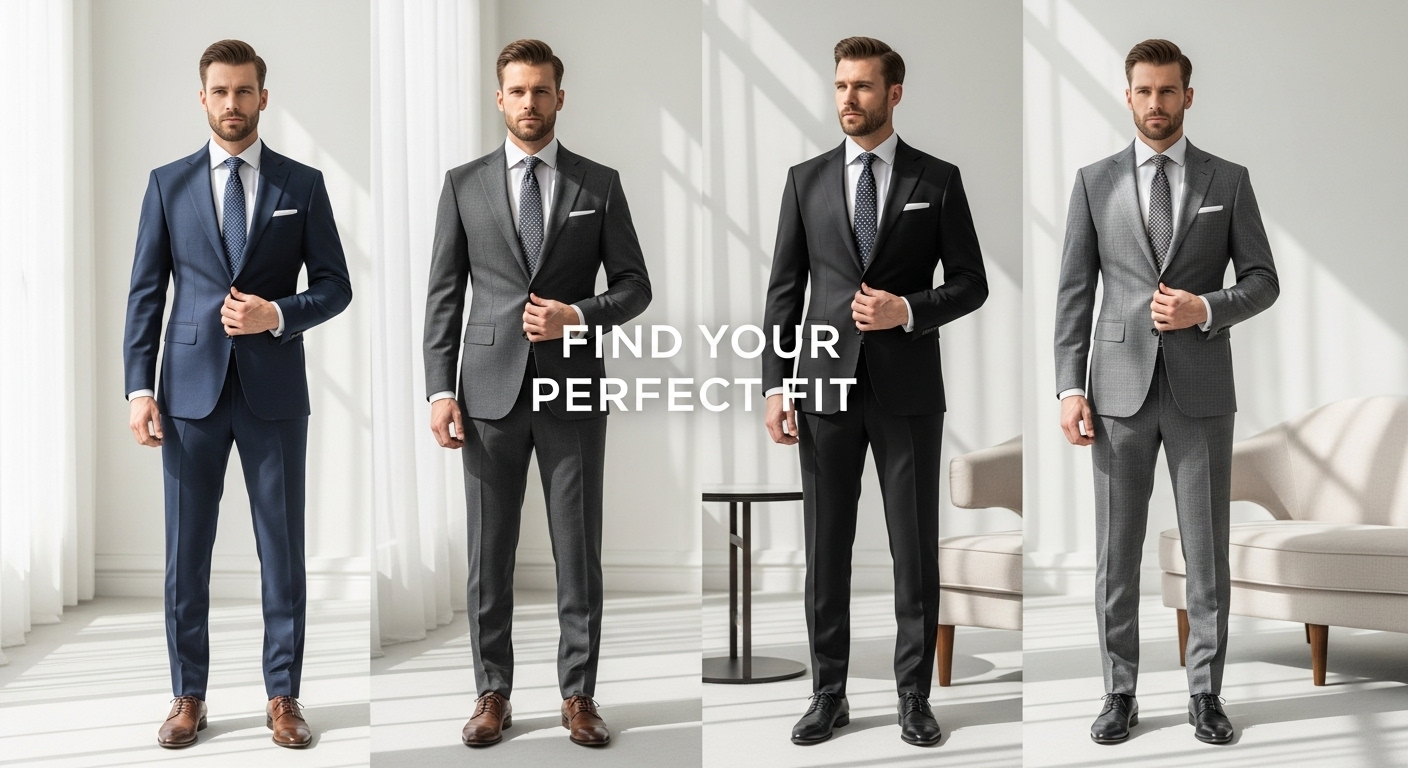Finding the perfect suit isn’t just about looking sharp—it’s about feeling confident in every moment. Whether you’re dressing for a wedding, an interview, or just upgrading your everyday wardrobe, the right fit can completely change how you look and feel. This guide will help you understand different suit fits, how to measure yourself correctly, and how to choose the one that suits your style and body best.
1. Understanding the Different Suit Fits
Men’s suits come in four main fit styles: Skinny Fit, Slim Fit, Modern Fit, and Classic Fit. Each one is designed for a specific look and comfort level.
Skinny Fit
The skinny fit is the most tailored option. The jacket has a narrow chest and waist, with higher armholes and fitted sleeves. The pants are slim through the seat and thigh with a narrow leg opening. This fit is sleek, trendy, and ideal if you prefer a sharp, contemporary style.
Slim Fit
A slim fit offers a more tailored look without being restrictive. The jacket features a closer fit through the chest and shoulders, while the pants are slim through the thigh with a slightly lower rise. It’s a great balance between fashion-forward and comfortable.
Modern Fit
Modern fit suits are the perfect middle ground between slim and classic. The jacket contours slightly at the waist for a tailored appearance while still allowing movement. The pants are slightly tapered without being tight. This is a great choice for men who want a clean, updated silhouette that’s still easy to wear.
Classic Fit
The classic fit provides the most room and comfort. The jacket has a traditional cut with extra space in the chest and waist, while the pants have a fuller leg and sit at the natural waist. This fit is timeless, comfortable, and perfect for men who prefer a relaxed, traditional style.
Style Tip: If you’re unsure which to choose, start with a modern fit. It flatters most body types and works for nearly any occasion.
2. How to Measure Yourself for a Suit
To find your correct suit size, you’ll need two main measurements: chest and overarm.
Chest Measurement
Wrap a measuring tape around your torso, just under your arms and across the fullest part of your chest. Keep the tape level and make sure you’re standing relaxed—don’t puff out your chest.
Overarm Measurement
Wrap the tape around your arms and chest, including your shoulder blades. Keep the tape level and relaxed. If the difference between your chest and overarm measurement is more than 7 inches, subtract 7 inches from the overarm number to get your jacket size.
Example: Chest 40″ and Overarm 49″ equals a size 42 jacket.
Getting these numbers right is the first step toward a perfect-fitting suit.
3. Fit Tips for Big & Tall Men
If you wear big and tall sizes, the right fit will enhance your frame and help you look your best.
- A properly fitted suit creates clean lines and a slimming effect.
- Stick with timeless colors like navy, charcoal, or black for a refined look.
- Consider custom tailoring to fine-tune the proportions and achieve a perfect fit.
Even small adjustments—like tapering the pant leg or shortening the sleeve—can make a huge difference.
4. Choosing the Right Suit for the Occasion
Different occasions call for different fits. Here’s a quick guide to help you decide:
- Job Interviews or Business Meetings: Choose a modern or slim fit suit for a polished and professional appearance.
- Weddings and Formal Events: Try a slim or skinny fit if you want a more fashion-forward and tailored look.
- Daily Office Wear: A classic fit is comfortable and dependable for long days at work.
- Casual or Smart-Casual Events: A modern fit in lighter fabrics like linen or cotton gives you a relaxed yet refined look.
5. The Perfect Fit Checklist
When you’re trying on a suit, keep these details in mind:
- Shoulders: The jacket seam should sit right on your shoulder—not past it.
- Chest: You should be able to button the jacket without it pulling or creating wrinkles.
- Jacket Length: The jacket should cover your seat and fall around your wrist when your arms are at your sides.
- Sleeves: About half an inch of your shirt cuff should show beyond the jacket sleeve.
- Pants: The waistband should sit comfortably without needing a tight belt. The pant legs should have a clean break above your shoes.
A great suit should feel like a second skin—structured, but not stiff.
6. Final Thoughts: Confidence Is the Best Fit
The best suit fit is the one that makes you feel confident and comfortable. It’s not just about trends or tailoring—it’s about finding your personal style. Whether you prefer a sleek slim fit or the timeless comfort of a classic cut, make sure your suit fits your body and your personality.
When your suit fits right, you’ll stand taller, move easier, and feel unstoppable.

